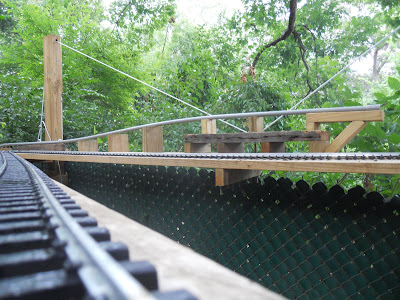From its formation in 1898 until the purchase of the two GE-70 Ton diesels in 1948, the Tallulah Falls Railroad ran entirely on steam power. At the turn of the century that meant wood burning locomotion, but photos in
Brian Boyd's book shows coal burning engines in photos dated as early as 1917.
While larger railroads used
coal towers to load tenders quickly, the TFRR built an elevated coal dock onto the tall embankment on the east side of the tracks just north of the shop so that any northbound locos would pass right by it.
Here's a snapshot of a photo of the coal trestle from
Dess Oliver's TFRR museum in Rabun Gap, which shows how open hopper cars filled with coal could be dumped through the trestle, then transferred to the locomotive tenders waiting on the middle level by men wielding the fleet of wheelbarrows seen on the middle level. I think I can see the headlamp of an approaching loco at the far right!

This 1922 Sanborn fire insurance map shows the location of the coal dock circled in red, found at the end of a block-long siding that is shown as originating just north of Clyde Place (now Elrod Street). Note the second siding that peels away to the southeast, serving "Robert Spencer's Planing Mill" and a "Lumber Storage" building or area, as well as a building labeled "Ice Factory" between the coal and industry sidings (circled in blue). Before the introduction of
mechanical refrigeration cars in 1951, all railroad cars of this type used ice to keep perishables fresh. However, whether or not the Spencer ice factory was providing this service to cars on the TFRR is unknown to me.

Here's a southbound view taken in 2009 that looks across Clyde/Elrod Street. The very end of the surviving TFRR mainline is on the right. At the left we can see the remains of the curved Spencer siding in the little alley between the two buildings. It may be my imagination, but it seems like there is a track-shaped double bump that crosses under the asphalt and continues directly under the parked semi truck in the spot where the map indicates the coal siding was located. Since the corner of existing warehouse sits atop this siding it must have been built after coal service ended.

However, upon shifting to a northbound view and moving alongside the same warehouse, we see the remains of a switch, the mainline on the left and the beginning of a siding that continues up the hill behind us. So perhaps the coal siding was merely shortened sometime after the November 1922 date on the Sanborn map?

Walking up the hill reveals tracks that are still in place, as well as a few concrete bases for uprights that are no longer present. All of these relics are virtually invisible under a tremendous tangle of kudzu, undergrowth and trees small and large.


Mysterious to me is this skeleton of a belt conveyor in the vicinity of the coal trestle. Was the labor-intensive trestle and wheelbarrow system abandoned in favor of this conveyor in the later years of steam power?
Using a conveyor to move coal directly from a hopper car to the steam engine's tender was a pretty common way of loading coal in small rail yards, but I don't really know if that's how this conveyor was used.

From the modeling perspective, conveyors are not as exciting as such an iconic feature as the original coal dock! The ice plant also offers nice potential, both for modeling of the structure and then as an operational feature when running trains, as it would make sense to send all reefer cars for icing either before running the train north or dropping those cars on the Southern Ry interchange track.






























